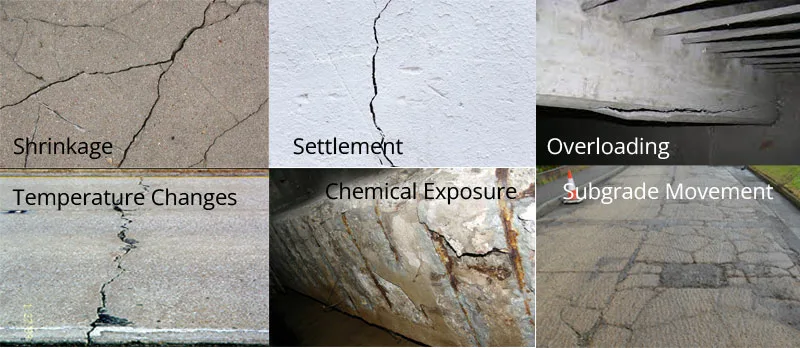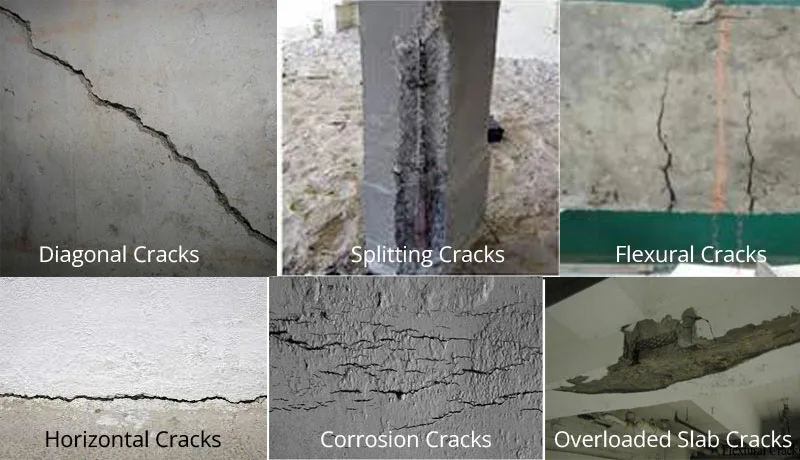Cracks in a Reinforced Concrete (RCC) slab refer to fissures or openings that develop within the concrete structure. They can emerge for a multitude of reasons, ranging from natural factors like temperature fluctuations and shrinkage to the consequences of suboptimal construction practices. These cracks can vary in size and severity, from fine surface cracks to more significant structural issues. Understanding the cause of cracks is essential to determine the appropriate repair or maintenance measures needed to ensure the slab’s integrity and longevity.
Causes of cracks in RCC slabs
Cracks can develop in RCC slabs due to various factors, including:
1. Shrinkage: Concrete undergoes shrinkage as it cures, which can result in small surface cracks known as shrinkage cracks. These are typically hairline cracks and are considered normal. Proper curing practices can help minimize them.
2. Settlement: Uneven settlement of the underlying soil or subgrade can create stress in the slab, leading to cracks. Poor soil compaction and inadequate site preparation can contribute to settlement-related cracks.
3. Overloading: Applying excessive loads or weight on the slab beyond its designed capacity can cause cracking. This often occurs in industrial settings with heavy machinery or equipment.
4. Temperature Changes: Extreme temperature fluctuations can lead to thermal expansion and contraction of the concrete, resulting in cracks. This is common in regions with significant temperature variations.
5. Chemical Exposure: Exposure to aggressive chemicals, such as sulfates or chlorides, can corrode the reinforcement within the concrete, leading to cracks and deterioration. This is particularly relevant in structures located near coastal areas or chemical processing plants.
6. Inadequate Reinforcement: Incorrect placement or insufficient quantity of reinforcing steel (rebar) can compromise the slab’s ability to resist tensile forces, making it more susceptible to cracking.
7. Improper Mix Proportion: Incorrect ratios of concrete constituents (cement, aggregates, water) or the use of low-quality materials can result in weakened concrete, leading to cracking.
8. Improper Curing: Insufficient or improper curing of the concrete after pouring can cause it to dry too quickly, resulting in surface cracks. Proper curing involves keeping the concrete moist for an appropriate duration.
9. Subgrade Movement: Soil movement or settling beneath the slab can exert uneven pressure, causing cracks. This can happen due to factors like soil erosion, tree roots, or changes in groundwater levels.
10. Design Flaws: Errors in the structural design, such as inadequate support or spacing of reinforcement, can lead to cracks when the slab is subjected to loads.
11. Construction Defects: Poor construction practices, including improper concrete placement, consolidation, and finishing, can result in weakened areas prone to cracking.
12. Lack of Control Joints: Inadequate provision of control joints or expansion joints can restrict the slab’s ability to accommodate thermal expansion and contraction, leading to random cracks.
13. Improper Curing: Without proper curing, the top layer of the concrete may become weak and susceptible to surface cracks, especially in hot and dry conditions.
14. Wrong Material Selection: Choosing the right concrete constituents, including aggregates, is crucial for reducing the risk of crack initiation. The use of alkali-aggregate in concrete, for example, can lead to crack development.

Types of cracks in RCC slabs
There are types of cracks that occur in RCC concrete slab, viz. Structural cracks and Non- Structural cracks.
Structural cracks in RCC (Reinforced Concrete) slabs are those that pose a significant risk to the structural integrity and load-bearing capacity of the slab and the entire building or structure. These cracks are often wide, deep, and can extend through the entire thickness of the slab. They result from factors such as overloading, inadequate reinforcement, settlement, temperature fluctuations, or chemical reactions that directly weaken the slab. Repairing structural cracks is a complex process, typically requiring substantial structural reinforcement, patching, or even replacing the affected area.
Non-structural cracks in RCC slabs, on the other hand, are primarily minor in nature and do not compromise the load-bearing capacity of the slab or the structural integrity of the structure. These cracks are usually narrower, shallower, and may only affect the surface layer of the slab. They can result from factors like shrinkage during curing, surface traffic, aesthetic imperfections, or minor temperature and moisture-related movements. Repairing non-structural cracks is generally less complex and may involve surface treatments, sealants, or cosmetic fixes to improve aesthetics.
Types of Structural cracks
Diagonal Cracks: Diagonal cracks are typically observed along the height of a reinforced concrete slab. They affect the entire face of the column and can compromise the slab’s integrity. Inadequate cross-section, insufficient steel reinforcement, or low load capacity of the column can cause these cracks.
Splitting Cracks: Short, parallel, and vertical cracks of varying widths are known as splitting cracks. These cracks occur in reinforced concrete slabs, especially when columns have inadequate steel reinforcement or low-quality concrete. Overloading the slab can also lead to splitting cracks.
Horizontal Cracks: Horizontal cracks can be found at the beam-column junction of a reinforced concrete slab, and in some cases, on the column face. These cracks result from insufficient reinforcements and a limited moment of resistance capacity. Incorrect reinforcement placement or shear force can also contribute to horizontal cracks.
Corrosion Cracks: Corrosion cracks typically appear near the reinforcement lines on the column of the concrete slab. They often have symmetrical widths and widen as the concrete ages. These cracks result from reinforcement corrosion or poor bonding between steel bars and concrete.
Overloaded Slab Cracks: Excessive weight placed on the concrete slab, particularly during or after snowmelt or heavy rain, can lead to substantial cracks that compromise the slab’s structure. Preventing such cracks requires consideration of the concrete’s PSI (pounds per square inch) before adding weight.
Flexural Cracks: These are typically diagonal cracks that occur due to bending or flexing of the slab. They are often found near load-bearing areas or where there is excessive deflection.

The list does not end, here to explore, other types of cracks that occurs in RCC slab visit- https://constrofacilitator.com/an-investigation-of-cracks-in-concrete-slab/
Types of Non- structural cracks
Premature Drying Cracks: Premature drying can cause two types of cracks: crusting cracks and crazing cracks. Crusting cracks occur during stamping when the slab’s top dries faster than the bottom. Crazing cracks have a shattered glass or spider-web appearance and occur when the top loses moisture too quickly.
Temperature-Related Cracks: Extreme temperature variations can lead to thermal expansion and contraction of the slab, resulting in cracks. These cracks are more common in regions with significant temperature fluctuations.

To know about other types of non structural cracks, visit- https://constrofacilitator.com/non-structural-cracks-in-concrete-slabs/
Repairing cracks in RCC slabs
Repairing cracks in an RCC (Reinforced Concrete) slab is crucial to maintain the structural integrity and durability of the slab. The appropriate repair method can vary depending on the type and severity of the cracks. Here are some common methods for repairing cracks in RCC slabs:
- Epoxy Injection: This involves injecting epoxy resin into the cracks to bond and seal them. It’s effective for both structural and non-structural cracks.
- Routing and Sealing: For wider cracks, you can widen them into a V-shape and then fill them with epoxy or polymer-based sealants.
- Grouting: If the cracks are due to settlement or voids beneath the slab, grouting can be used to fill these voids and stabilize the slab.
- Overlay or Resurfacing: This method involves applying a new layer of concrete or polymer-modified overlay to the entire slab to cover and reinforce the existing cracks.
- Stitching: In this method, holes are drilled across the cracks, and metal rods or staples are inserted and bonded with epoxy to hold the crack together.
- Carbon Fiber Reinforcement: Carbon fiber sheets or strips can be bonded to the surface of the slab over the cracks to provide additional strength and prevent further cracking.
- Caulking and Sealants: For non-structural cracks, flexible sealants or caulking can be used to fill and seal the cracks, preventing water infiltration.
- Concrete Patching: Small cracks can be repaired by removing the damaged concrete and replacing it with fresh concrete or a suitable repair mortar.
- Control Joint Installation: In some cases, creating control joints at specific intervals can help redirect cracks to these predetermined locations, reducing their visibility and impact.

Tips to avoid cracks in RCC slabs
Preventing cracks in Reinforced Concrete (RCC) slabs involves careful design, construction practices, and maintenance. While it may not be possible to completely eliminate the risk of cracks, you can significantly reduce their occurrence by following these tips
- Use a well-balanced concrete mix with the right proportions of cement, aggregates, and water.
- Consider adding additives like plasticizers or superplasticizers for improved concrete performance.
- Ensure correct placement and sizing of steel reinforcement (rebar) per engineering specifications.
- Install control joints or expansion joints at regular intervals to control crack locations.
- – Perform adequate curing using compounds, wet methods, or covering with wet materials to maintain moisture.
- Construct formwork correctly and securely to prevent movement during concrete pouring and curing.
- Employ proper pouring and compaction methods to minimize air voids and ensure uniform distribution.
- Avoid exceeding the slab’s design capacity by limiting heavy loads during construction.
- – Use moisture barriers or waterproofing membranes in moisture-prone areas beneath the slab.
- Protect the slab from extreme temperatures, freeze-thaw cycles, or corrosive substances.
- Apply proper finishing method for a smooth surface without imperfections.
- Regularly inspect and maintain the slab, addressing any issues promptly.
- Consider consulting a structural engineer for complex applications to ensure compliance with standards and specifications.
Conclusion
Understanding and addressing cracks in RCC (Reinforced Concrete) slabs is important for the longevity and safety of structures. Regular inspection and maintenance, along with consultation with structural engineers when needed, can help diagnose the cause, assess severity, and determine the appropriate measures for repair and reinforcement.

